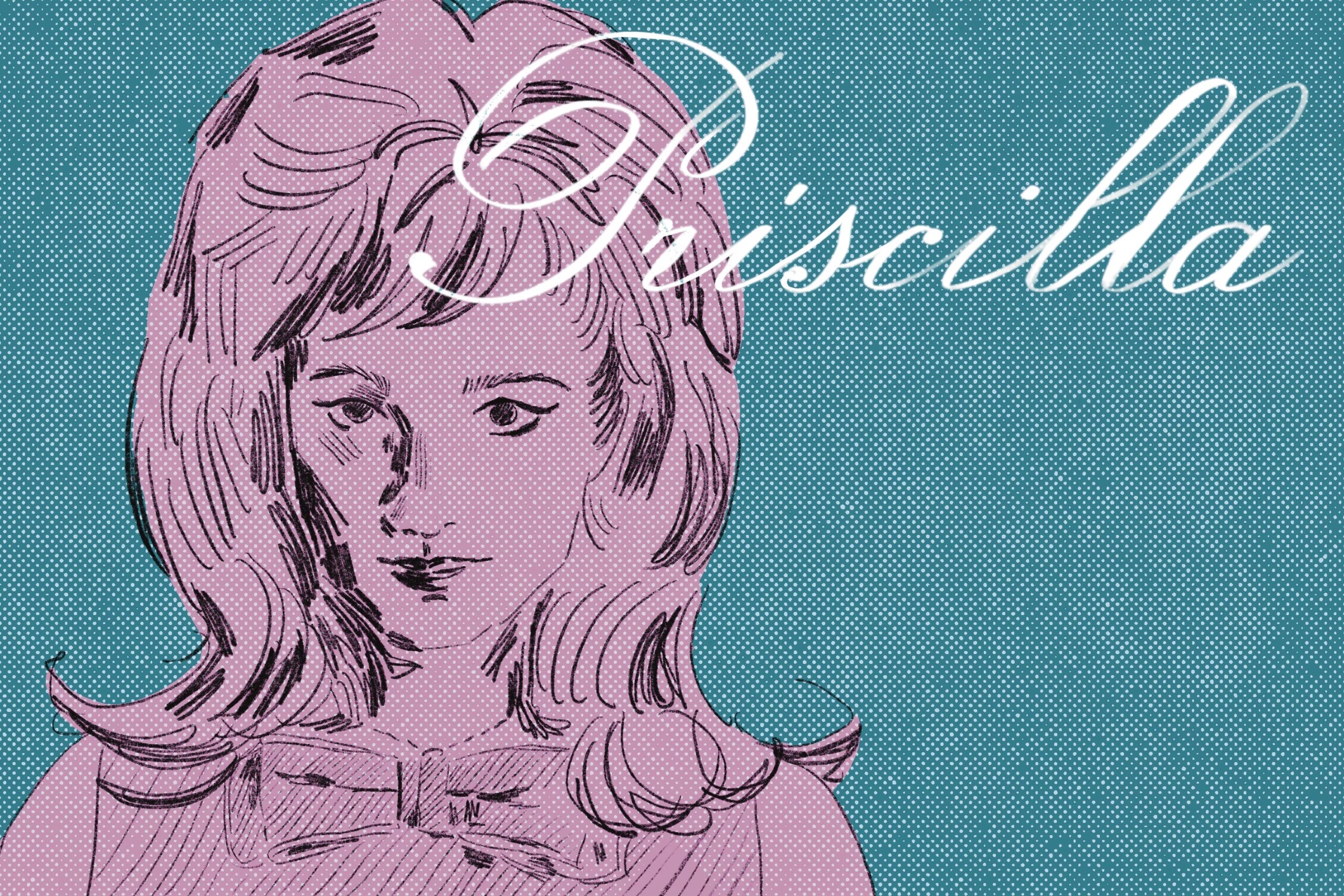Opening the gates of Graceland, director Sofia Coppola leads the audience into the world of Prisiclla’s fragile love story, in her film simply entitled “Priscilla,”. Coppola aimed high and completely transported viewers from the world of today into 1960s Graceland. “Priscilla” is inarguably one of the best films to come out of 2023 due to Coppola’s meticulous and authentic lens, setting the bar high for other directors and performers. . Coppola’s “Priscilla” captures what it is like to be a woman who is unrealistically idolized and groomed by her romantic partner. The female perspective that is shown throughout the film has an important impact on what we as the audience absorb.
A Background on “Priscilla”:
Based on Priscilla Presley’s memoir “Elvis and Me,” Coppola’s “Priscilla” dramatizes the relationship between Priscilla and Elvis Presley. The film’s title cues to the audience that this will not be told from a dual point of view, and it is made unmistakably clear with vague details of abuse and grooming what is happening during the film. This is a love story wrapped in abuse and neglect.
The story of Priscilla Beaulieu Presley is the leading storyline within this blast from the past film. Played amazingly by Cailee Spaeny, she embodies all of what young Priscilla was. The ideal Sofia Coppola leading lady is petite but powerful, while capturing the power of silence which turns into severity. Coppola makes her leading ladies the wheels of her films, with actresses like Kirsten Dunst, who appears in both “The Virgin Suicides” and “Marie Antoinette.”
Another signature of Coppola is the visual elements in all of her films, so cinematically pleasing along with any transition scene she has. Coppola is a pro at encapturing the feeling of girlhood in all of her films and continues to do it so magically.
She begins Priscilla’s destined relationship with Elvis with Priscilla and Elvis at his home, off the United States Military base in West Germany in 1959. When Priscilla was just 14-years-old, she was drawn right into the world of Elvis Presley. The tone and perspective of this movie is not fabricated with lies; instead, we are shown a controlling manipulative man and a child who has to clean up the pieces of another person’s messed up past and dark fame.
With most of the film taking place within a duplicate Graceland, it feels as if we are watching a doll begging to be picked up and played with for an hour and fifty minutes. This fragile environment that Priscilla lives in is shown in many ways.
“I’d have to ask my parents,” she responds — a stabbing reminder of how young Priscilla was when Elvis invited her into his world.
Behind the Scenes: Actors & Music
One can not watch this without being utterly scared of Jacob Elordi’s Elvis. Sofia Coppola’s leading men in her films all seem to be damaged, which can be seen in Elodi’s past roles,which I find quite limiting and repetitive. Elordi was able to capture the feeling of one losing their sanity and embracing the dark demonic mentality; plus, Elordi’s accent is spot on, and luckily he left it all behind when he got off the studio lot.
Further, this film’s soundtrack is the epitome of what falling in love feels like– especially if you are falling in love with the tainted Elvis Presley during the 1960s. Old love songs are present throughout, like “Crimson and Clover” by Tommy James & The Shondells or “Sweet Nothing” by Brenda Lee. The timelessness of these songs represent the age in which Elvis and Priscilla were living and reflect the creativity and stylistic changes that define that decade. Music is also used to show that change is coming throughout the film. One of the best musical choices is during Priscilla’s transformation scene. As Coppola does in all of her female montage scenes, Priscilla’s hair gets volumized as the slowed-down piano version of “Aura Lea” captures how time has crawled to a halt for the heartbroken Priscilla.
Surprisingly, this film could not and does not use a single Elvis song as per request of Elvis’s estate. In my opinion, this fact is one of the strongest aspects of this film, working perfectly in Coppola’s favor. This opens up our interpretations of Priscilla because the audience can momentarily separate Priscilla from Elvis. The spotlight of this film does not cover Elvis, nor do we ever see him do a real performance (thank goodness). The scenes solely revolve around Priscilla.
The Unseen Life of Priscilla
While teenagers across the globe are writing Elvis with their dip pens and hearts around his name, Priscilla has her hand wrapped tight around the real thing. What feels like a fairy tale love story to the teenager soon takes a turn for the worse when she is brought into his world.
One of the first scenes of Priscilla and Elvis arriving home in Memphis is her being given two heavy-dose sleeping pills from her twenty-four-year-old boyfriend, causing her to sleep for the first two full days of her trip. Elvis’s drug abuse has seeped its way into Priscilla’s life; feeling pressured to fit in with Elvis, she finds herself partaking in his late-night illegal activities. This young sixteen-year-old girl finds herself at a crossroads with herself and this new lifestyle.
Trapped like an animal in a cage, Priscilla changes her appearance to appeal to Elvis’s wants in a transformation scene that highlights the amazing directing. While trying to keep the attention off of herself and on her star-studded boyfriend, Priscilla follows any demand that is given to her. Constantly at battle with herself and their relationship as the cheating rumors around Elvis continue to circulate, she is banished to the bedroom with nothing to do but play dress up. Continuing to extend herself sexually, she is constantly denied and undesired. Eventually, the two marry, and in a major directorial choice, Coppola dials in on a classical wedding scene, highlighting a different angle of the wedding rather than what the audience sees in the previous Elvis film. With a timeless dress designed by Chanel, Priscilla is the epitome of a baby bride. The clear isolation and dissociation on Priscilla’s face throughout the scene is jarring.
Coppola’s cinematographic genius is on display all throughout the film, but nowhere more than a scene at the dining table, where Priscilla sits next to Elvis. Sat at the table as well is Elvis’s band who seems to always be following in his shadow. The disappointing reunion is clearly affecting young Priscilla; with distress all over her face, she lets the men lead the conversion. Having finally been reunited with the man she’s been dying to see since he left for Hollywood, she tries to appreciate the moment but fails to. Between the acting and the visual choices, this scene rings more memorable than most others in the film, and for good reason. The camera remains on Spaeny for a significant length of time, the only eyes on her being the audience in the theatre. Everyone around the table is enchanted by Elvis, with the band reminiscing on their past escapades. Coppola creates a scene where the audience can feel the lingering disappointment Priscilla is feeling. This serves as a climactic point in the film and the couple’s relationship as a whole, as Priscilla learns where her place is (metaphorically and physically): just sit and be pretty in Memphis.
All throughout the film, Coppola paints a clear picture of what Priscilla’s day-to-day life was like. We rarely see Priscilla outside of the gates of Graceland; when she is, there is usually a request from Elvis for her to go back. A doll has more chances of leaving the dollhouse than Priscilla did, with their relationship being solely centered around Elvis’s needs and wants.
“Priscilla”: Closing Thoughts
After watching this movie, I found myself feeling claustrophobic on Priscilla’s behalf. Spaeny depicts Priscilla from the age of 14 to 27 and does so with versatility. The character’s progression is physically and emotionally tenable throughout the film. Only seen leaving Graceland less than a handful of times, her life turns into a repetitive playdate. The contrast between the naive and lovestruck schoolgirl and the wife who simply couldn’t bear to remain in the relationship, is portrayed so notably.
Between the skillful acting of Spaeny and Elordi and the dominating direction of Sofia Coppola, “Priscilla” beautifully illustrates the imposed life and recounts the harsh truths within her relationship with the King of Rock ‘N’ Roll. “Priscilla” appears to have solidified itself as one of A24’s best films, along with one of my new favorites as well.









